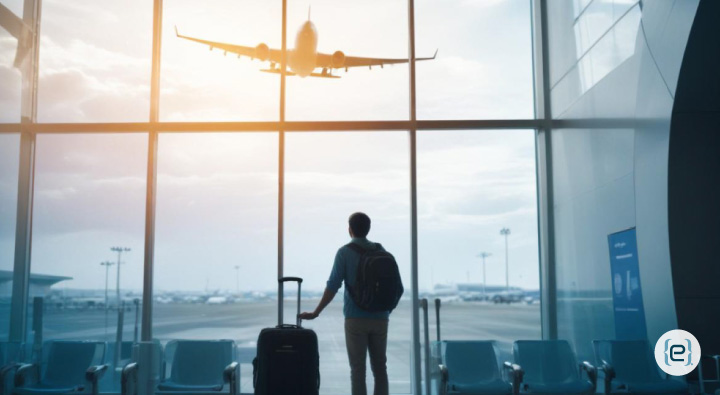Flying Through Digital Storms: The Hidden World of Airport Cybersecurity


That Time My Flight Almost Never Happened
Picture this: you’re at JFK, watching the departure board flicker like a retro screensaver. Suddenly, flights vanish, reappear in Chinese, and then the screens go dark. The guy next to you jokes about hackers. Twenty minutes later, no one’s laughing when all check-in systems across three terminals crash.
Behind the Digital Curtain
When you think airport security, you likely picture metal detectors and bag searches. But there’s a hidden battle raging behind the scenes. Airports are essentially massive networks—giant computers with planes attached. Every system is connected: baggage handling, air traffic control, fuel systems, and even those overpriced sandwich shops.
When Coffee Reveals Secrets
Last month, during a layover in Dubai, I chatted with an airport IT expert over a cup of (predictably expensive) coffee. What he shared was chilling: major airports fend off hundreds of cyberattacks every single day. Not yearly. Not monthly. Daily. Imagine the pressure on those teams.
The Worst Case Scenarios
What keeps airport security leaders up at night? It’s more than credit card theft at duty-free. Modern planes are flying computers. Their maintenance and navigation systems are digital, and ground control is entirely computerized. One successful breach could have catastrophic consequences—no need to spell it out.
The Forgotten Networks
Even the smallest details can be a risk. Those arrival screens and self-check-in kiosks? Each is a potential entry point for hackers. My IT friend once traced a breach attempt to a hacked vending machine. Now, I look at every “out of order” sign with a little more suspicion.
- Unexpected Weak Points: Even vending machines and digital signage can be exploited by cybercriminals.
- Multiple Attack Surfaces: Every connected device in an airport is a potential gateway for hackers.
Your Phone Could Be the Problem
Ever been asked to turn on your laptop at airport security? It’s not just to prove it’s real—they’re watching for modified devices that could hack into airport systems. Some hackers have tried using innocent-looking phones and laptops to access secure networks.
The Human Factor
The biggest vulnerability isn’t always technology—it’s people. That “free airport WiFi” might not be legitimate. The USB charging station could be harvesting your data. Even the guy asking to borrow your phone might not be as stranded as he appears.
- WiFi Risks: Always verify the network before connecting—fake hotspots are a real threat.
- USB Charging Dangers: Avoid public charging stations for sensitive devices.
The Dark Side of Convenience
We love digital conveniences—online check-in, mobile boarding passes, automated baggage. But each new feature opens new vulnerabilities. It’s like building more doors and forgetting to lock them.
- More Features, More Risks: Every new convenience brings potential security gaps.
The International Challenge
Airport cybersecurity gets even more complex internationally. Airports must coordinate security across countries, airlines, and legacy systems that don’t always play nicely together. As my Dubai friend put it, it’s like trying to get a hundred bands to play the same song with different conductors.
Ghost in the Machine
Threats aren’t always obvious. One airport’s air conditioning system was hacked—not a big deal, right? Except those ACs also cool the server rooms. When the servers overheated, critical systems went down. Sometimes, the smallest disruptions have the biggest impact.
The Business Class Problem
Business and first-class lounges are prime targets. High-value travelers use “secure” WiFi to handle sensitive business, but hackers know this too. These spaces need extra protection.
Fighting Back: How Airports Defend Themselves
Airports are innovating their defenses. Some deploy AI to spot suspicious activity, others use “honeypot” traps to lure hackers, and many hire ethical hackers to test their systems. It’s a constant digital chess match.
- AI for Cybersecurity: Airports leverage AI to detect and respond to threats faster than ever. AI to spot unusual patterns is now a frontline defense.
- Proactive Security: Ethical hacking and honeypots are just some of the creative strategies in play.
The Future is Already Here
The landscape is only getting more intense. As airports adopt facial recognition, automation, and AI-driven systems, the number of attack points multiplies. Some teams are already preparing for quantum computing threats—it’s no longer just science fiction.
What It Means for You
So, what can you do as a traveler? Besides steering clear of sketchy WiFi and random USB ports, awareness is your best tool. Understand the risks and be patient when systems go down for “routine updates”—there’s often more happening than meets the eye.
- Don’t use public WiFi for sensitive transactions.
- Avoid public USB charging stations.
- Carry a book or offline entertainment for unexpected delays.
Personal Take—and a Call to Action
After my JFK scare and that Dubai coffee chat, I changed how I travel: no banking on airport WiFi, no public charging, and always a backup plan for digital downtime. Next time you fly, remember—behind every screen, camera, and automatic door, there’s an IT team fighting off the latest digital threat.
Want to know how your business can build this level of resilience? Contact eMazzanti today to learn how we help organizations secure their networks and stay a step ahead of cyber threats. Safe travels—and safe systems—start with smart security.
Recent Posts
Look Inside For Cyber and Insider Threats
In more than 20 years of speaking at events, I have noticed a recurring theme…
AI-Powered Software Slashes Law Firm Costs and Boosts Efficiency
Artificial Intelligence (AI) is transforming industries across the board, but its impact on the legal…
Make Sure Your Point of Sale System Is On Point
Point of sale (POS) systems are helpful for both retailers and customers. They let consumers…
Counter Dark Web Threats With AI-Backed Cybersecurity Tools
Businesses of all sizes today are confronting a rising number of sophisticated cyber security threats,…
A Cybersecurity Workout
Greetings! I am Carl Mazzanti, and I have been sharing my thoughts in these kinds…
Step Up Your Threat Response With Security Copilot
As we move deeper into 2025, you are probably focusing on ways to expand your…


